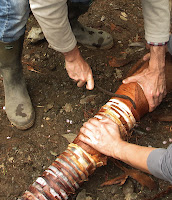They look scrappy but a novelty that most houses in the area have one on their land somewhere. There was one looking out of place above the pond when it was dug a few months back. Who likes to cut down a distant relative that wasn't particularly doing anything obnoxious except looking scruffy and out of place? (I know the feeling actually and felt some sympathy for the poor thing stuck in a place it really shouldn't be.) Fate seems to have dumped it there. It took root and there it was making the best out of life. I couldn't do it myself so I had a friend to take it down.
The old guy next door saw me trying to skin it with a regular sickle. He brought over this special Yeti skinner he had in the back of his barn. The woven matted fur was traditionally used to make good quality cord for garden work. It took a few hours to cut off the stuff and it was difficult to convince anyone it was a pile of palm tree bark when it obvious it was a pile of Sasquatch/Yeti scalps.
It doesn't take much to imagine that humans first got the idea to weave something by looking at the naturally occurring weave.
After the yeti has been scalped it is necessary to untangle the mottle of unbroken fibers that were closest to his head.
With some twisting and rubbing it is possible to groom the fur to look like this:

Then things got blurry when Ogata san just went wild on the thing ripping it and tearing it into strips like a veteran Yeti skinner gone mad.
Here is Ogata san in her slow motion glory, almost purring like a cat, as she manhandled that Yeti fur into a rope that she will use to to go out and trap another of these unsuspecting silent men in the forests of Japan. She won't take us hunting with her. Perhaps it is her secret of how she manages the stalk and the actual kill or perhaps she uses some magic that isn't fit for our mortal eyes.
Look at her expression...all in a days work!




















































